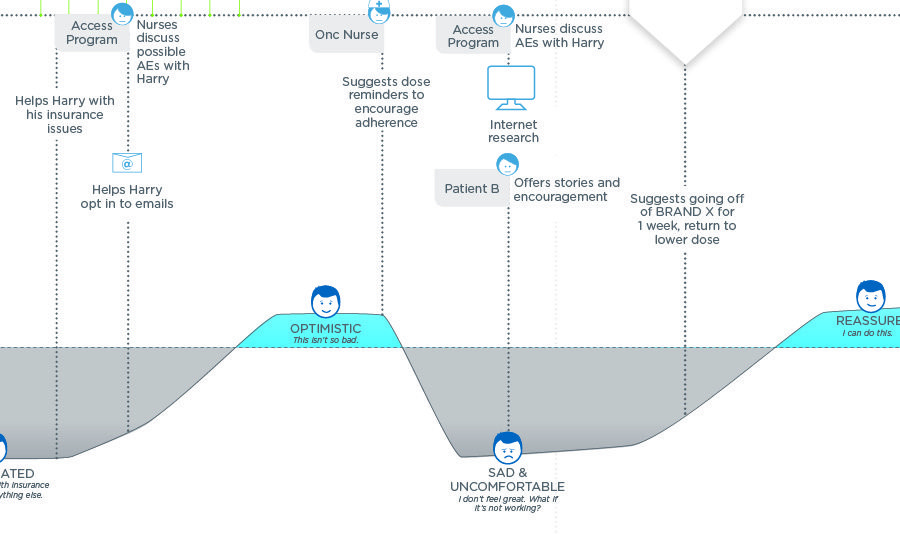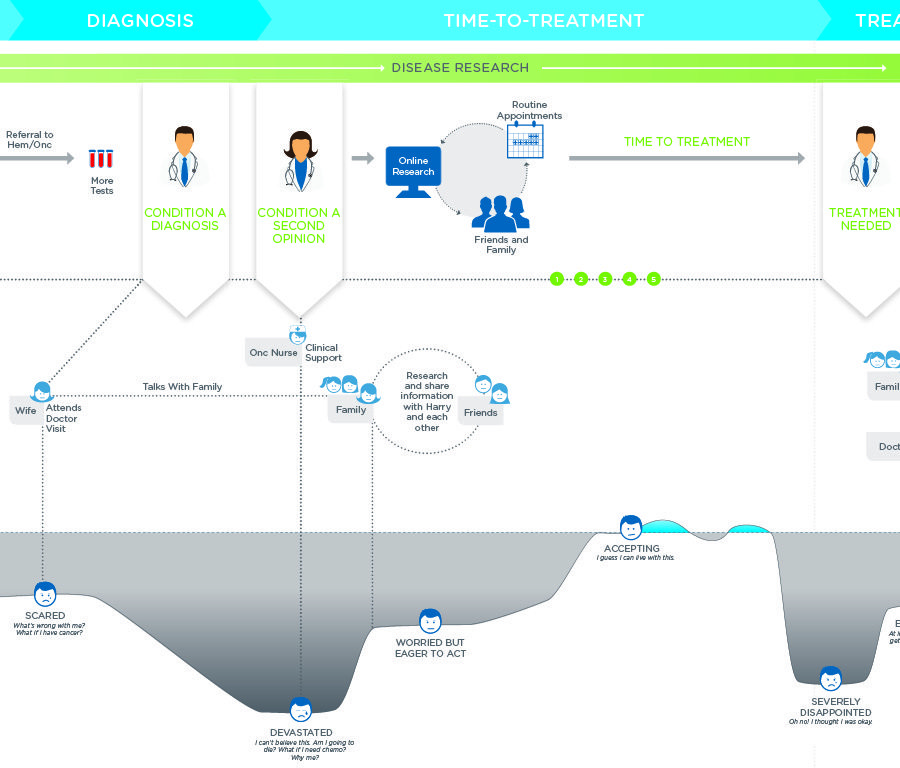Don’t underestimate the power of journey mapping and its impact on connecting with—and marketing to—the customer. An effective tool for turning customer insights into marketing communication planning, mapping creates a longitudinal snapshot of a customer’s journey. And that customer may be a patient managing her own health condition, a physician treating a particular patient, or a director of pharmacy managing hospital drug purchases. Journey mapping has grown in popularity because of its power and effectiveness in successfully engaging with customers on an ongoing basis.
Journey mapping is the process of visually mapping the customer’s emotional journey and interactions across the various touchpoints of the customer’s experience. This is a visual longitudinal roadmap of each stage of the process a customer goes through—whether a patient, physician, or caregiver—from diagnosis to treatment and beyond.
In the example below, for instance, this section of a journey map shows how nurses help Harry with his insurance, medication, adherence issues, and side effects; how other patients offer encouragement and support; and how Harry’s moods change throughout his journey.
Meanwhile, the top section of the journey map below shows the people who diagnose, treat, and support Harry, including healthcare professionals, family members and friends. It also shows how Harry’s moods change throughout his journey.
The significance of journey mapping is that it identifies the specific emotions customers feel about their—or other people’s—conditions. In addition to pinpointing their wants and needs, it helps identify their behaviors and attitudes toward their illnesses, the people they interact with, their touchpoints, the media they use to search for information, and how they maintain contact with others as related to their condition.
With the innumerable opportunities for engaging customers today, crystallizing these factors has never been more critical—or challenging. However, by mapping customer journeys, we can define the optimal marketing strategies for creating a plan that provides an effective customer experience, generating awareness, interest, evaluation, trial, and adoption of a brand.
While some companies already leverage journey mapping, making it part of their standard marketing process, many are still exploring its use. Applying both qualitative and quantitative marketing research models along with actionable data techniques keep the focus on the customer.
Keep these seven tips in mind to help you create a successful customer journey mapping strategy:
1. Clarify your objectives
Customer journey mapping requires you to identify customer needs and problems you want to solve. Do you need to improve your customer service? Strengthen brand messaging? Identify customer media and touchpoints? Predict customer brand adoption? In many cases this will include a combination of elements. Properly executed, journey mapping allows you to walk in your customers’ shoes, understand their challenges, and empathize with them. It helps you gain a better understanding of their behavior, what they want and need from a product or service, and how well it satisfies their needs. This will form the foundation for effective engagement.
These customer interactions create an ongoing data stream that provides a constant view of how effectively your marketing strategy—and dollars—are working. It also reveals where you are engaging with your customers, where and how your brand connects with them, and the key moments that make the difference.
2. Develop customer “personas”
Journey mapping methodology is based on specific, predefined customer “personas”—representative target customers who are going through a typical journey. They are created by using qualitative research to study the actions of actual customers, focusing on their attitudes, behaviors, and demographics, which then become the main factors in creating personas.
Let’s say your brand is a treatment for psoriasis. To develop a persona for your map, you would interview a wide range of psoriasis patients to find out about their thoughts, feelings, wants, and needs toward their condition. Some of the discussion would include what it’s like living with the condition, how they deal with symptoms on a daily basis, what they currently do to manage it, and what are their current and past treatments. You would then use this information to create a profile of a “typical psoriasis patient,” who then becomes the representative for the mapping exercise.
3. Include your customer’s “circle of influence”
As you develop your journey mapping strategy, you’ll need to include and engage your customer’s “circle of influence.” These are called external stakeholders and are the people—both professional and personal—who come into contact with patients and influence decisions during their condition journeys. They help customers find information, make decisions, and manage their conditions, and include caregivers, HCPs, payers, family, advocates, and friends.
4. Start the mapping exercise: Involving all internal stakeholders in the mapping process
You also need to include internal stakeholders in constructing the actual customer journey. These are corporate people—those who represent the brand—and include marketing, sales, research, and clinical. While they may all work on the same brand, internal stakeholders often have specific viewpoints on how customers approach their conditions and interact with the brand. All are an important part of the brand and can contribute to the mapping process. Bringing them together during the mapping exercise helps build consensus, create a single customer strategic direction, and develop a shared sense of ownership in the final product.
5. Validation: Moving from hypothetical to reality
Once your internal stakeholders have constructed an initial—and hypothetical—map, you need to share it with them all, getting their buy-in and confirming their ownership of the final product one more time.
Then it’s time to validate the map with the external stakeholders. Does the timeline look right? Is this what the patient would feel immediately after being diagnosed? After six months? After a year? Would the customer share her experience with this group of people? Is this what she would read? It’s at this stage that you’ll tweak your map, confirming its accuracy or adjusting it to reflect any new input from your external stakeholders. Once all participants confirm their agreement, your validated map is ready for action.
6. Turn insights into action
Your validated maps provide a clearer view of how to approach your customer, allowing you to develop strategic imperatives at specific points along the customer journey. They not only provide insights into your customers’ emotions and behaviors, but clarify the content and messaging strategies that will most effectively engage them.
Suppose that during the mapping exercise of a psoriasis patient, a brand manager discovers that many patients in the early stages of the condition go online to view photos of psoriasis skin conditions so they can match them to their own. This information may spur the product manager to offer—or develop—a downloadable app that allows these patients to compare and identify their skin conditions with those in the photos. The map allows product managers to illustrate the steps a patient may take to identify her particular skin condition and to find and download the brand-sponsored app. It also allows them to map a CRM program that engages the patient once she connects and identifies her condition at the app download site.
7. Go from predictive modeling to quantifying customer engagement
Effective customer journey mapping is an iterative process that allows you to develop a lasting analytic infrastructure that ensures ongoing, actionable insights. It also allows you to continue analyzing and using these data to gauge the performance of your communications strategy, based on additional insights you uncover when your programs are actually launched. At this point, you can either confirm or make any additional modifications to enhance your marketing effectiveness and impact.
Finally, you’ll also need to set up statistical predictive models as key performance indicators (KPIs) to measure and analyze communications that are put into action, along with measuring campaign and program performance. Gauging communication effectiveness requires additional quantitative and qualitative analysis but will give you an understanding of what’s working and what’s not so your programs stay on target.
Data In, Data Out, Data In
While there are many ways to understand your customers and what they mean to your brand or service, mapping their longitudinal journeys is an effective visual way to plan an approach for engaging them. This process can be accomplished only with an effective data framework. From qualitative customer research that defines personas to quantitative data analysis that confirms your statistical hypotheses, an effective mapping process gives you continual feedback about your customers and how best to optimize engagement as they connect with your messages and your brand.









